20.03.2006
N.Vitiugov. Portrait of a chessplayer - Alexander the Great, part I
– How do you see your future in the world of chess?
– At the age of 25 I understood that the chess is not my calling but only a temporary pastime or one of the methods of intellectual development. I don't know what I'm going to do in future but I'm absolutely sure that I won't play chess for the whole life. Actually, I can be a lecturer in physical education at school but it doesn't really attracts me either.
(From the interview of Alexander Morozevich to the "Moscow News" 13.01.2006)
Author's foreword
First of all this article must have a subtitle "The portrait of Alexander Morozevich by N. Vitiugov". Just so because any other author would see and describe a talent of the article's hero differently. That's why I ask the readers not to be offended if they consider my point of view to be far from reality. The criticism can always be expressed in the Internet and at the personal meeting. Besides the description of the creative work of Alexander, I will try to disclose his method of chess improvement (in order to help young chess players including myself), however pathos it sounds.
It was already announced in my previous article in this column that consistency is above all in writing. The headings of the article are relative - there could be more or less of them. Some examples will be given without headings because the author's imagination has its limits. Don't be hard on me!
For some reasons the author was writing this article for several months. By no means it demonstrates the quality of the article but only means that it's a bit uneven. Such is the author's confession.
Spiel mit mir
What is the distinction of Alexander Morozevich from other elite chess players? On the one hand, the answer is very simple and it can be put in one sentence. On the other hand, the whole article addresses this question. In the present column I would like to note one feature of the Muscovite – first and foremost he is a player. He plays a game that is called chess. He is not doing some kind of work that's been boring him for a long time. He never serves out at the board.
A. Morozevich (2590) – Y. Yakovich (2570) B31
Maikop 1998
1.e4 c5 2.¤f3 ¤c6 3.Ґb5.
Now this variation has become rather popular at the high level. In that way White avoids the Sveshnikov Variation. And eight years ago the young Muscovite simply played chess.
3...g6 4.0–0 Ґg7 5.¤c3
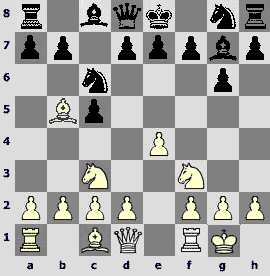
It is one of the favorite moves of Alexander. But I'll tell about it later.
5...¤d4. Several months later Yuri Rafailovich tried 5...d6, but he didn't achieve success again: 6.e5 dxe5 7.Ґxc6+ bxc6 8.¦e1 f6 9.b3 ¤h6 10.Ґa3 Јa5 11.¤a4 c4 12.d4 cxd3 13.cxd3 Ґg4 14.d4 Јd5 15.¤c3 Ґxf3?
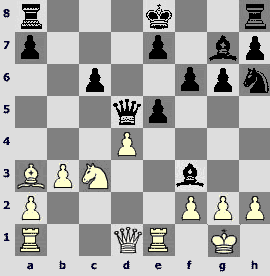
16.Јd3!ѓ Morozevich – Yakovich, Samara 1998.
6.¤a4!? More standard 6.¤xd4 cxd4 7.¤e2 Јb6!? was also possible.
6...Јa5?! The Јueen's onslaughton such an early stage of the game can hardly be considered as a successful one. 6...e6 7.¤xd4 cxd4 8.¤b5 Јb6 9.c3!?ѓ. Probably, the best way was to continue chasing the light-squared bishop – 6...a6!?
7.¦b1! White informs of his intentions without beating around the bush – а3 and b4!
7...e6? Just after this developing move Black finds himself in a difficult situation. It was worth choosing between two moves that ignore development:
7...a6!? 8.¤b3 (an attempt to give a hostile reception to b7-b5 by b2-b4 was nipped in the bud: 8.a3?! ¤xf3+ 9.Јxf3 Ґxc3 10.Јxc3 Јxc3 11.bxc3 b5 12.Ґb3 c4 13.Ґa2 d5!„) 8...¤xb3 9.axb3‰ d6! (Doctor Tarrasch was not the only one who didn't allow Black to disgrace himself by the move 9...¤h6 – 10.d4 cxd4 11.¤d5!ѓ) 10.d3 ¤f6 11.e5І.
Perhaps, it was necessary to decide in favor of the impudent 7...b5!? 8.¤xd4 cxd4 (8...Ґxd4? 9.Ґxb5; 8...bxa4 9.¤de2І)9.b4! This "push" frightened off the grandmaster from Samara, didn't it? However, the Black's queen could come backhome as if going downstairs: 9...Јa6 10.Ґxb5 Јb7 11.¤d5 Јb8 12.Ґc4 e6 13.Јf3ѓ
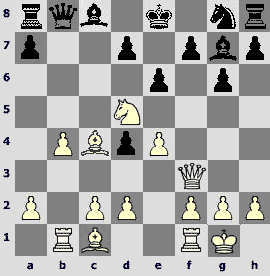
And White must prove that there was a reason for the knight d5 to hang.
8.a3 b5?
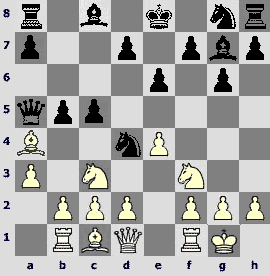
I think that it is a decisive error. It happens very often: you will burn down quickly in case you stand to principles and if you lose heart then you will be spitchcocked. As far as I understand, the public opinion supposes that a real man should hold his ground till the end. It is a debatable but not a chess problem. After 8...¤e7 9.b4ѓBlack could hold out but then Јa5 would look silly.
9.b4 Јa6 10.bxc5! Abody punch. After it the position of Black goes into pieces. 10...¤xf3+ (10...bxa4 11.¤xd4 Ґxd4 12.¤b5 Ґe5 13.Ґb2!ќ) 11.Јxf3 bxa4 12.¤b5 ўe7 (in response to 12...Ґe5 White wins by 13.Ґb2ќ) 13.d4!±

Here comes a stereotyped comment: "The avalanche of white pawns is ready to sweep away everything on its way".
13...f6?! 13...Јc6!? was the best practical chance but even here the advantage of White is rather big. He just needs to choose how to convert it: 14.d5 (14.Ґf4!? e5 15.Ґxe5 Ґxe5 16.dxe5‚) 14...Јxc5 15.Ґe3 Јc4 16.d6+ ўf8 17.¤c7 Јc6 18.e5 Јxf3 19.gxf3І.
14.¤c7 Јc6 15.d5ќ
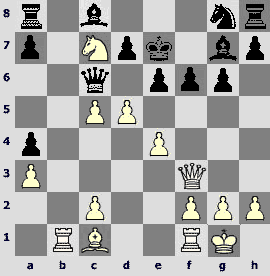
It is impossible to take the knight because of the loss of the queen. There is no sense in commenting the rest – the game was played in a team competition, so Black made seven moves more.
15...Јxc5 16.¤xa8 Ґa6 17.¦e1 ¤h6 18.Ґe3 Јc8 19.d6+! ўxd6 20.Ґxh6 Ґxh6 21.Јxf6 Јf8 (21...Јxa8 22.¦ed1+ ўc7 23.Јe5+) 22.¦ed1+ 1–0
Those who don't think the Sicilian defense with Ґb5 to be a strong enough opening, or those who consider it to be bad can have a look at the next game.
A.Morosevich (2575) – M.Hebden (2520) C22
London 1994
A legendary "Lloyd's bank open" was won by Morosevich with a phenomenal score – 9,5 points out of 10.
1.e4 e5 2.d4
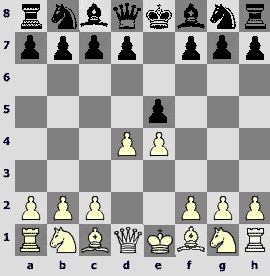
As simple as that. The Central Opening. Without any nuts.
2...exd4 3.Јxd4 ¤c6 4.Јe3 ¤f6 5.¤c3 Ґb4 6.Ґd2 0–0 7.0–0–0 ¦e8 8.Јg3 d6. Of course, it is more principled to accept a sacrifice of the pawn – 8...¦xe4!? This move led to a very unclear position in the following game: 9.a3 Ґd6 10.f4 ¦e8 11.¤f3 ¤h5 12.Јg4 ¤f6 13.Јh3 Ґf8 14.g4 d5 15.f5 d4 16.Ґc4 dxc3 17.Ґxc3 Ґd6 18.g5©
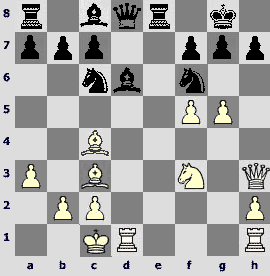
Zhang Zhong – Koneru, Wijk aan Zee 2003. It appears that this unpretentious opening is fraught with many hidden dangers. Using a logic line of reasoning, it is really better than the Albin's Countergambit, the Scandinavian defense or the Blackmar-Diemer. And the positions look rather fresh. A decent opening!
9.f3 ¤e5
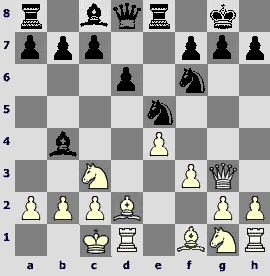
Black starts playing in the center. Everything is decorous and correct. And White challenges the position of the Black's king by the edge pawn.
10.h4 c6?! (10...ўh8!? 11.h5 h6 is more circumspect) 11.h5 d5 12.¤ge2 ¤c4 13.h6. For 13.Ґh6 Black prepared a nice response 13...¤g4!
13...g6 14.Ґg5. Oops! Black has already been pinned and the commentator missed that.
14...Јb6

No, it turns out that Black is not pinned. A non-standard with a lot of calculation to do position arose. Black played in a logical way, stood to principles again and lost the game quickly.
15.¦a4! White still wants to capture the f6-knight. It was impossible to capture it right away: 15.Ґxf6?! Ґd6 16.¤xd5 cxd5 17.f4 ¦xe4ѓ.
15...Јa5 16.Ґxf6 Јxa4 17.¤c3! Thatis a reasonable disregard of the edge pawn. 17...Ґxc3 18.Ґxc3 ¤e3. Black couldn't take on a2 at once – 18...Јxa2?? 19.Ґxc4 Јxc4 20.Јd6ќ.
19.b3 Јxa2 20.¦d2 Јa3+ 21.Ґb2 Јe7 22.Ґe2!ќ
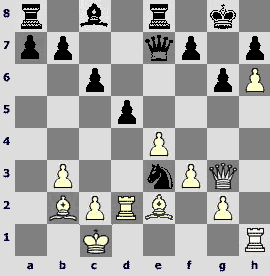
The smoke cleared away. The Black's queen came back home safely but the e3-knight looks like an army of Napoleon that had stayed in Egypt.
22...dxe4 23.fxe4 Јxe4 24.Јg5 ¤d5? Probably a time trouble blunder. However it was impossible to change anything. The h-pawn fulfilled its task and the weakness of the a1-h8 diagonal is incompatible with the continuation of the game. 24...Јe6 25.¦d8ќ.
25.¦xd5 Јxd5 26.Јf6 ўf8 27.Ґc4 1–0
Who is a spieler? (The author of these lines did not mean anything negative or skeptical by this word as many chess players who consider themselves to be the outstanding strategists do). I will try to draw an analogy with the American cowboy or with any other franc tireurs. The simple truth is common for them – they can count only on their abilities, on the strength of their hands and on the strength of the spirit. They don't have heavy armour but they have everything necessary. Rendering into chess language – in my opinion Alexander has developed skills of the player that can come in handy in any situation on board (regardless of pawn structure, king's safety or material ratio) –ability of attacking and defending, ability to calculate long variations, ability to find out resources that are not obvious... We will assure ourselves of it many a time. And for now – here are two examples of defending a worse position and calculating variations.
V.Kramnik (2772) – A.Morozevich (2745)
Wijk aan Zee 2001
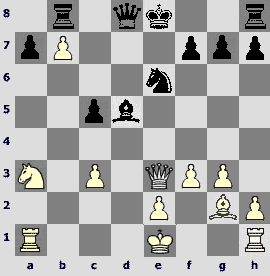
White's position is better. Black's pawn structure is somewhat ruined and the pieces are sort of hanging. But all the same White needs to take direct and decisive measures.
19.0–0?! This move isn't bad but it is not the strongest either. White starts playing too simply. 19.Ґh3!? was more energetic.
19...¦xb7 20.¦fd1 ¦d7. Black tightened up. But he will still need to have patience.
21.c4 (21.¦d3 0–0 22.¦ad1 Ґc6=) 21...Ґc6 22.¦xd7 Ґxd7 23.¤c2 Ґc8! A strong move. Black takes the d-file under control and at the same time resolves the problem of the a7-pawn defense.
24.Јd3?! Perhaps it was better to play 24.f4 0–0 25.Ґd5, keeping a certain pressure.
24...Јxd3 25.exd3 a6 26.f4 ўe7=
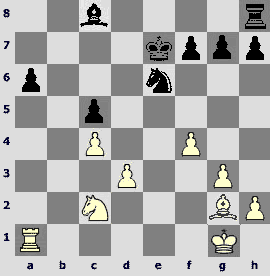
The endgame is equal. It seems that White, impressed by the opening's advantage, starts playing too boldly and opens up.
27.f5 [27.ўf2=] 27...¤c7 28.¦a5 ўd6 29.d4. On the one hand, it is a logical move that helps White creating a passer in the center. On the other hand, Black gets rid of the weak c5-pawn and the White's pieces lose strong outposts in the center. 29.Ґe4 ¦e8 30.ўf2=; 29.¤e3.
29...cxd4 30.¦xd4. It was impossible to promote at once. 30.c5+ ўe5 31.c6+ ўf6 32.¤xd4 ¦d8і.
30...¦e8 31.ўf2? Missing a blow. The situation is so typical that... All in all it is typical. White forgot himself in playing and it is rather difficult for him to change for playing for a draw. Probably the weakness on f5 must have been moved to be destructed: 31.f6!? g6 (31...gxf6 32.c5+©) 32.¤f3 h6 33.ўf2 ўe6 34.¦c5 ўd6 35.¦a5=. Or it is better not to define the position by the move 31.¤f3!?
31...¦e5!ѓ
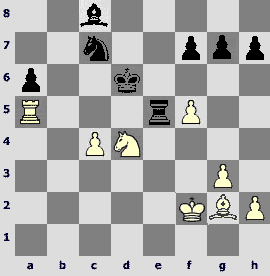
32.¦xe5 (32.¦a1 ўc5!µ (32...Ґxf5? 33.Ґb7 a5 34.¤b3=)) 32...ўxe5 33.ўe3 ўd6! Preventing White from organizing the perpetual check – 33...f6 34.c5 Ґxf5 35.¤c6+ ўe6 36.¤d4+=.
34.ўd3 a5 35.ўc3 Ґd7. Maybe it is a bit more adroit to fix the structure by 35...f6!? first.
36.Ґb7. Depriving the knight of the a6-square. 36...f6. Itis very important not to hurry! 36...ўe5 37.Ґc6 Ґxf5 38.¤b3=.
37.g4 Ґa4?!“. The time trouble tells. Black hasn't decided yet to move the passer further and that's why he takes no action for a couple of moves. 37...a4!? 38.ўb4 (38.¤f3 ўc5 39.¤d2 ўb6 40.Ґf3 ¤a6ѓ) 38...ўe5і.
38.h3 Ґd7 39.¤b3 a4 40.c5+. This is a direct consequence of the delay of Black on the 37th move. 40...ўe5

41.¤d2? In factWhite gives up by the first move after control. 41.¤d4™ a3 (41...ўf4? 42.c6 ¦e8 43.¤e6+ќ) 42.¤c2„, and a heated fight would develop with a new power.
41...¤d5+! Black removes the knight in order to give it for the pawn in perspective. At least, this move isn't trivial. And how strong it is!
42.ўc4 (42.Ґxd5 ўxd5 43.ўb4 a3°) 42...¤e7 43.¤f3+ (43.ўb4 ўf4 44.ўa5 a3 45.ўb6 Ґa4!°) 43...ўf4. The king is not obliged to guard the c-pawn anymore.
44.¤d4 ўg3 45.c6 ¤xc6!°

The game is decided. The a-pawn that is still alive distracts the White's king and White's minor pieces can't stop Black's kingside pawns.
46.¤xc6 ўxh3 47.¤d4 ўxg4 48.Ґe4 (48.¤e6? ўxf5 49.¤xg7+ ўg6°) 48...ўf4 49.Ґc2 a3. The Black's pieces interact excellently. White can't capture even the a3-pawn.
50.ўc3 (50.¤e6+ ўe5 51.ўb3 Ґa4+°; 50.ўb3 ўe3; 50.Ґb1 h5°) 50...h5 51.¤e6+ ўe5 52.¤xg7 h4 53.Ґd1 h3 54.Ґf3 Ґxf5 55.¤h5 Ґg6 56.ўb3 Ґxh5 57.Ґxh5 h2
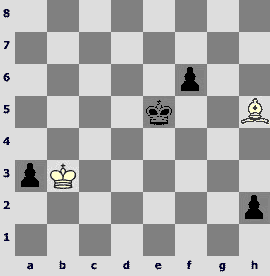
Now we can drop the curtain.
58.Ґf3 ўf4 59.Ґh1 ўe3 60.ўxa3 f5 61.ўb3 f4 0–1
A.Morozevich (2575) – D.Sermek (2515)
Moscow (Olympiad) 1994
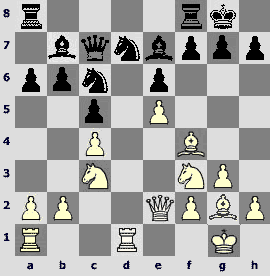
One of the most favorite openings of Alexander is on board. The position on the diagram has already been played by his opponent nevertheless I don't think that White's blow had been prepared at home.
14.¤d5!± (14.h4 ¦fd8 15.h5 ¤f8 16.¤e4 ¦xd1+ 17.¦xd1 ¦d8 18.¦xd8 Јxd8 19.b3 h6 20.¤c3І Psakhis – Sermek, Groningen 1993)
14...exd5 (14...Јc8!? 15.¤xe7+ ¤xe7±) 15.e6. Coward 15.cxd5?! ¤cxe5 16.¤xe5 Ґd6 17.¤xd7 Јxd7 18.Ґxd6 Јxd6= leads to the equal position.
15...Ґd6 16.Ґxd6 Јxd6 17.¦xd5 ¤d4. This counterblow must have been foreseen beforehand. 17...Јxe6? 18.Јxe6 fxe6 19.¦xd7±.
18.¤xd4. Otherwise White could have lost the advantage – 18.¦xd6?! ¤xe2+ 19.ўf1 ¤xg3+ 20.hxg3 fxe6 21.¤g5 Ґxg2+ 22.ўxg2 ¤e5 23.b3 ¦ad8!„.
18...Ґxd5 19.Ґxd5 cxd4 (19...fxe6 20.Јxe6+ Јxe6 21.¤xe6±) 20.exf7+ ўh8 [20...¦xf7 21.Ґxf7+± ўxf7? 22.Јf3+ќ) 21.Ґxa8
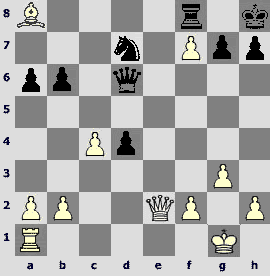
The forced play ended. 21...¤f6. White has a decisive advantage because Black can't take the bishop: 21...¦xa8 22.Јe8+ Јf8 23.Јxd7ќ.
22.Јf3 ¦xf7 23.¦d1ќ¦f8 24.Ґb7 b5 25.Јa3! It isplayed in keeping with the best traditions of Vassily Vassilyevich Smyslov – do you remember his legendary Јh4 ?
25...Јxa3 26.bxa3 ¦d8 27.c5 ¤e8 28.ўf1 ўg8 29.ўe2 ¤c7 30.ўd3 ўf7 31.¦e1 ўf6 32.f4 ¤e6 33.¦e5 g5 34.c6 1–0. The calculation of the variation that started with 14.¤d5! could only be stopped on the 21st move. The tree of variations was not very branchy but it was really lanky.
Rum and Pepsi-Cola
I wanted to give another name to this part of the article. Russian team along with the national football teams of other countries participated in the World Football Championship, which took place in 2002 in Japan and Korea. Alexander Mostovoy was considered to be one of the stars of the team but unfortunately he didn't play a single match out of three in the tournament. The official reason was an injury.
And now turning back to the heading. An enigmatic contract with the Coca-Cola company was considered as one of the unofficial reasons which indirectly prevented him from playing in the land of the rising sun. So, there was published an article, dedicated to those gossips, which was called "Sasha and Pepsi-cola". Well, we won't clown around. Although it will be more correct to say that we will keep the limit of playing the clown for other quiddity. The more so as I want to view the lines of the famous masterpiece from a new perspective.
Everyone drinks the alcohol,
Though it is very harmful,
And the drink Pepsi-Cola
Is extremely health-giving.
M.¤aumenko, "Rum and Pepsi-Cola".
I think that this quatrain can be a figural expression of Morozevich's approach to the opening. Namely – everyone plays the Naidorf and the Grünfeld; everyone tries to find an advantage in the Sveshnikov and the Queen's Indian. Everyone undertakes some long and supposedly forced variations and chess turns into heartless computer-cooked compilation of the other's ideas and games. And properly speaking who are the judges? Why can't we pave our own way? Does it matter for us that the theory considers that the Chigorin's defense and the Closed Sicilian are not the best openings? Well, we will play and see who is really stronger. More so since in such openings the risk of running into home prepared moves and becoming the co-author of the best novelty is minimal if it is presented at all.
A.Shirov (2695) – A.Morozevich(2630) D07
Amsterdam 1995
1.d4 d5 2.c4 ¤c6
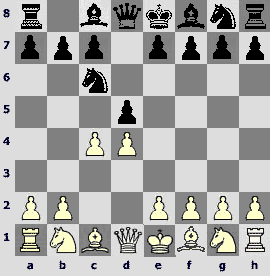
As it was stated above, the queen's knight move to c3 has always been especially dear to Alexander. And the Chigorin's defense is the opening which completely owes Morozevich its temporary revival (now its popularity starts decresing). 3.¤c3 dxc4 4.¤f3 ¤f6 5.e4. White tries to construct a powerful pawn center, which will be attacked by the Black's pieces.
5...Ґg4 6.Ґe3 e6 7.Ґxc4 Ґb4 8.Јc2 0–0 9.0–0–0?! It is a questionable decision. Several rounds before in the same tournament van Wely got an advantage after 9.¦d1 ¤e7 10.Ґe2 Ґxc3+ 11.bxc3 c5 12.0–0 Јc7 13.Јb1 b6 14.h3 Ґh5 15.g4 Ґg6 16.Ґd3 ¦fd8 17.¤e5 Јb7 18.f3 cxd4 19.cxd4 ¦ac8І, van Wely – Morozevich, Amsterdam 1995.
9...Ґxc3 10.bxc3 Јe7 11.h3 Ґxf3 (11...Ґh5?! 12.g4 Ґg6 13.Ґd3!І) 12.gxf3
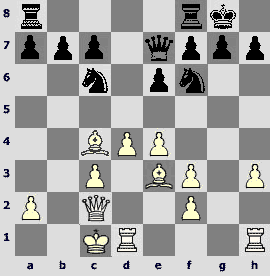
The White's centre is very powerful. Both central pawns of White are supported, both white bishops are in action but there is still a problem – the White's king is a bit misplaced.
12...¦fb8ѓ 13.Ґd3 b5! The h7-pawn is not very important. It is really more important not to grant a respite to White.
14.e5 ¤d5 15.Ґxh7+ ўh8 (15...ўf8!?) 16.Ґe4 b4. Black begins initiating action immediately. The other opportunity consisted in transferring the knight to c4 – 16...¤a5!?
17.Ґxd5. This move is forced. White couldn't avoid opening files by 17.c4?! because of 17...b3 18.axb3 ¤a5!
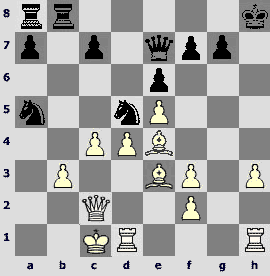
19.¦dg1 (19.¦de1 Јa3+ 20.ўd1 ¤b4‚; 19.ўd2 ¦xb3!‚) 19...Јa3+ 20.ўd1 ¤xe3+ 21.fxe3 ¦xb3‚.
17...exd5 18.ўd2 ¤a5 19.ўe2 ¤c4і. The superiority of the Black's knight over the White's bishop as if caused Black's advantage. An extra pawn is of no importance.
20.Ґd2 c5?!
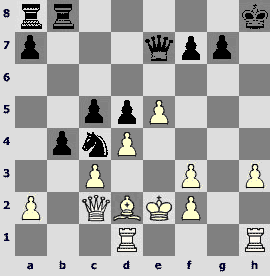
Black is right considering that his king is more secure than its counterpart. That's why he aims at opening the play. However, in this case it is not the best decision. It looks like it was preferable to bring in the rook: 20...¦b6 … 21.cxb4 a5.
21.¦hg1 ¦b6 22.¦g5! A good move. White uses the absence of the h7-pawn and weakens the shelter of the Black's king.
22...g6 23.dxc5 ¤xd2 24.Јxd2 bxc3?! The advantage rapidly passes into the hands of White. Why did the author mention this game? The answer for the curios readers will be given a bit later. 24...Јxc5› kept the tension.
25.Јxc3 ¦a6 (25...Јxg5 26.cxb6 axb6 27.e6+ѓ) 26.f4 ¦c8 27.¦xd5 Јe6 28.¦d2?! It was even stronger to play 28.Јc4! ¦a4 (28..¦d6)

29.¦d4 ¦xd4 30.Јxd4 Јxa2+ 31.ўf1ќ) 29.Јxa4 Јxd5 30.e6! Јxe6+ 31.¦e5 Јxh3 32.¦e8+ќ.
28...¦xa2 29.¦xa2 Јxa2+ 30.ўf1 ўg8. These precautions are obligatory. It is dangerous for Black to keep this opposition on the a1-h8 diagonal.
31.f5 ¦d8 32.ўg2 Јd5+ 33.ўh2 Јe4 34.e6!
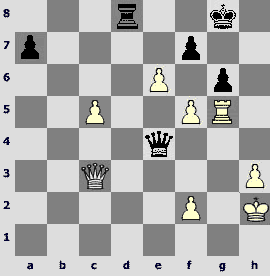
It seems that Black must resign. What can he count on? Not on the a7-pawn, at least.
34...Јf4+ (34...¦d3 35.exf7+ ўxf7 36.fxg6+ ўe6 (36...ўg8 37.Јf6ќ) 37.Јxd3 Јxd3 38.g7ќ) 35.Јg3 Јxg3+ 36.¦xg3 fxe6 37.fxe6 a5 38.¦xg6+ ўf8
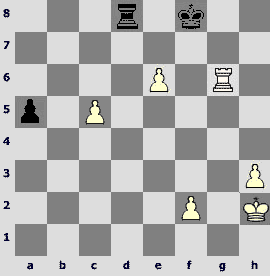
There is a rook ending with four White's pawns against a single Black's pawn, which is even not very advanced. Two White's pawns have moved considerably farther. The only chance for Black consists in the remoteness of his passed pawn and in the abundance of winning opportunities for White.
39.¦g4? White immediately makes a mistake. One shouldn't place the rook in front of the pawn voluntarily. White can win directly – 39.e7+! ўxe7 40.¦a6 ¦d2 41.ўg3 ¦a2 42.h4 a4 43.h5 ¦c2 44.h6 ўf7 45.¦xa4 ¦xc5 46.¦g4ќ. And the most simple and logical decision is 39.f4!ќ.
39...ўe7? A reciprocal mistake. It was possible to use inaccuracy of White immediately: 39...¦c8! 40.¦c4 ўe7І.
40.¦a4? The simplest rules are the most effective ones. The exclusions are very rare. White should have placed the rook behind the pawn, even at the cost of losing the tempo – 40.¦g7+ ўxe6 41.¦a7 ¦d2 42.ўg3 ¦a2 43.h4 ўf6 (43...ўd5 44.h5! ўxc5 45.h6ќ) 44.f4 ўg6 45.ўg4 ¦g2+ 46.ўf3 ¦a2 47.ўe4ќ.
40...¦a8 41.f4? White seems to be demoralized by the resistance of Black in such a hopeless, at first glance, ending and after putting the rook in the most passive position he abandons two pawns one after another. After this move the position is drawn. 41.¦e4 ¦a6! 42.h4 ¦c6!І.
41...ўxe6=
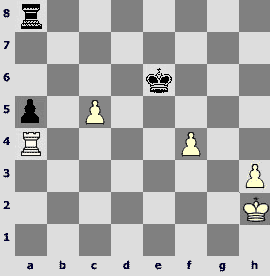
42.ўg3 ўd5 43.ўg4 ўxc5 44.ўg5 ўb5 45.¦a1 ¦g8+ 46.ўf6 ¦f8+ 47.ўe5 ¦e8+ 48.ўd5 ¦d8+ 49.ўe5 ¦e8+ 50.ўd5 ¦d8+ 51.ўe4 ¦e8+ 52.ўf3 ¦h8 53.¦h1 ўc5 54.f5 ўd6 55.ўf4 a4 56.ўg5 ўe7 57.f6+ ўf7 58.¦b1 ¦xh3 59.¦b7+ ўf8 Ѕ–Ѕ. The author used the comments by Shirov.
W.Anand (2794) – A.Morozevich (2749) D11
Dortmund 2001
1.d4 d5 2.c4 c6 3.¤f3 ¤f6. TheSlav defense is an opening that can be studied using the games of the article's hero.
4.e3 a6 5.Ґd3 Ґg4 6.Јb3. Modest 6.¤bd2 doesn't promise an opening advantage for White: 6...e6 7.0–0 ¤bd7 8.b3 Ґe7 9.Ґb2 ¦c8 10.c5 Ґf5 11.Јc2 Ґxd3 12.Јxd3 a5 13.a3 b5 14.b4 a4 15.¤e5 0–0 16.f4 ¤e8 17.¤df3 f6 18.¤xd7 Јxd7 19.g4 e5= Kramnik-Morozevich, Monaco 2004.
6...Ґxf3 7.gxf3. It is possible to take thepawn but there is no guarantee that the queen will be able to get out: 7.Јxb7 Ґxg2 8.¦g1 dxc4 9.¦xg2 cxd3! 10.Јxa8 Јc7 11.¤d2 e5 12.dxe5 ¤d5 13.¤c4 Ґb4+ 14.Ґd2 0–0 15.¤d6 ¤b6 16.Ґxb4 ¤xa8 17.¤f5 g6 18.¤h6+ ўg7 19.¤f5+ ўg8 20.¤h6+ ўg7 Ѕ–Ѕ Sorokin – Alavkin, St.Petersburg 2003.
7...¦a7

Without complexes and heart-searching. The pawn should be defended – and Black defends it. The idea of this move can be too deep and unclear but I assure you that it exists. Although 7...Јc7!? is also playable and is surely more comprehensible for an average men.
8.¤c3 e6. As the further attack of the b7-pawn doesn't promise big profit, White moves the queen to a more usual for such structures position.
9.Јc2 Ґe7 10.Ґd2 0–0 11.0–0–0. A determined approach. Preliminary closing the position by 11.c5!? looks preferable.
11...¤bd7. Black continues developing modestly without defining the pawn structure. 11...dxc4!? 12.Ґxc4 b5 13.Ґe2 c5 also deserved attention.
12.cxd5. Vishwanathan continues playing in the same way. If you made a decision, stick to it. Get off the doubts!
12...cxd5 13.e4 ўh8
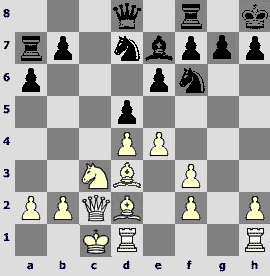
For the moment Alexander acts rather modestly and treats with respect his eminent opponent. On the other hand, there are no obvious weaknesses in the Black's position but he has certain perspectives of developing the initiative on the queenside. Generally speaking, the position is unclear.
14.e5 ¤h5 15.Ґxh7?! We have seen something like that recently, haven't we? After White took the edge pawn, the opponent's game on the opposite side of the board develops according to the snowball principle. The farther – the bigger. And it was almost the last active move of White in this game. He had to undertake preventive measures like f4!? … 15...b5 16.Ґe2 or 15.ўb1!? b5 16.¤e2.
15...b5 16.ўb1 ¦c7. Clarifyingthe idea behind Black's 7th move. He placed the rook on the open rank and soon he will be able to double the rooks without wasting a tempo unnecessarily.
17.Јd3. To seize the initiative White had to undertake the computer-like17.Ґg6!? fxg6 18.Јxg6 ¤f4 19.Јg4 b4 20.¤a4, and Black will have to give the knight back– 20...¤e2 21.¦he1 ¤xd4 22.Јxd4 ¦xf3›. Although with all the respect to the computer such opportunity is hardly believable.
17...Ґg5!
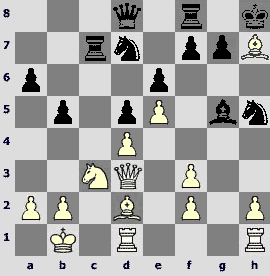
A top-class move. In spite of the fact that the Black's position is a bit non-typical, Alexander continues acting in a positional way. The square f4 is good for a knight on the whole and especially in front of the double pawns "f".
18.f4. And White, having a bishop on h7, should think about variations instead of the schemes. It looks interesting to play 18.¤xd5!? exd5 19.Ґa5 ¤f4і, though in this variation Black's position is better too; 18.h4? Ґxd2 19.¦xd2 f5°.
18...Ґxf4 19.Ґxf4. 19.Јf3 was followed by 19...Јh4! . And in the endgame after 19.Јh3 Јg5 20.Ґc2 Ґxd2 21.Јd3 Јh6 22.Јxd2 Јxd2 23.¦xd2 f6іBlack has better chances.
19...¤xf4 20.Јe3 Јh4 21.Ґc2? It is a loss of a tempo and it is unclear what it was caused by. White would have a bit worse position after 21.Ґd3.
21...¦fc8 22.Ґd3 ¤b6і
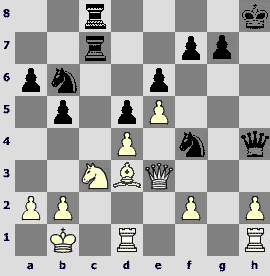
The advantage of Black is obvious. All his pieces are in action and on the right squares. White will have to defend passively. A tempting sacrifice of an exchange 22...¦xc3 doesn't work because of 23.bxc3 ¦xc3 24.Јg3 Јh6 25.Ґxb5!ќ.
23.¤e2?! White should have driven the Black's queen on the less active position first – 23.Јg3 Јh6 24.¤e2 ¤xd3 25.Јxd3 ¤c4 26.¦hg1і.
23...¤xd3 24.¦xd3 ¤c4 25.Јf3 Јe4!µ. This is an excellent moment for transition into the endgame. 26.Јxe4 dxe4 27.¦h3+ It is not the best square for the rook but there wasn't any choice. It is absolutely hopeless to play 27.¦c3 b4 28.¦cc1 ¤d2+ 29.ўa1 ¦c2 30.¦xc2 ¦xc2 31.¤g3 ўh7, and White won't be able to save this endgame.
27...ўg8 28.¦d1? The last error of the Indian genius. 28.¤c3!?µ allowed him to hold out somehow in a worse position.
28...¤xb2
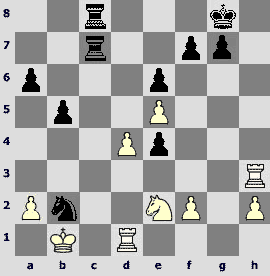
0–1
E.Bacrot (2645) – A.Morozevich (2679) C43
Biel 2003
1.e4 e5 2.¤f3 ¤f6 3.d4. Unusual method of meeting the Petroff defense runs across an unusual response.
3...exd4 4.e5 ¤e4 5.Јxd4 f5!?
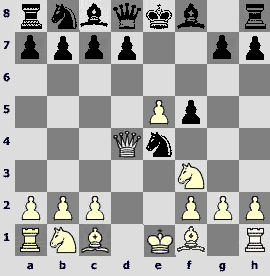
It is beautiful, isn't it? I don't think that the move f5 is the strongest in this position. But, basically, it is not really important. This is an interesting move, isn't it? The bunglers who are bored with chess and who play only because of the absence of other earnings will be surprised and indignant at such play, won't they? The children, who don't know yet what enjoying the ancient game means, will fix their eyes on the monitor when they see this diagram, won't they? And if the time will give to the author at least one positive answer, then the article wasn't written for nothing.
6.Ґc4. White... transposes into the endgame. Another opportunity is 6.Ґe3!? d5 7.exd6 Јxd6 8.¤bd2 ¤xd2 9.Ґxd2 ¤c6 10.Јa4 Јe7+ 11.Ґe2 Јe4 12.Јc4 Ґe6 13.Јxe4 fxe4 14.¤g5 Ґf5 15.0–0–0 h6 16.g4І Sveshnikov – Pashikian, Stepanakert 2004.
6...Ґc5 7.Јxc5 ¤xc5 8.Ґg5 Јxg5 9.¤xg5. This kind of queen exchange is not the most trivial one.
9...¤c6 10.0–0. It is a bit academically. White had to bother Black right in this position: 10.f4!? ¤e6 11.¤xe6 dxe6 12.¤c3 a6 (12...Ґd7!?)13.0–0–0 b5 14.Ґe2 Ґb7 15.Ґf3І, and White has some pressure.
10...¤e6 11.¤f3. In this case, the exchange on e6 will not give any tangible advantage to White: 11.¤xe6 dxe6 12.f4 Ґd7=.
11...b6. Black could play more ambitiously – 11...a6!?
12.Ґd5. White tries seizing more space. 12.¤c3!? is also a possible decision.
12...Ґb7 13.c4 0–0–0 14.¤c3
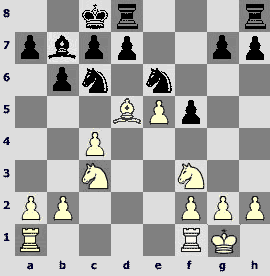
A complex endgame is on board. White has more space and more opportunities for the maneuvers but the Black's position is more solid. Generally speaking, the result of the game depends on the further actions of both players. It's very difficult to get a position with such assessment by the 14th move of the Petroff defense!
14...h6. Black plays very solidly. An immediate 14...g5!? is also possible.
15.¦ad1 g5„ 16.¦fe1 ¦he8. All the pieces are brought to action. ¤ow it is time to advance a pawn.
17.¤b5?! This move is wrong. The White's idea, though a bad one, can be explained – he takes the square d4 under control for the time being. It was stronger and more logical to play 17.a3!? a6 (17...g4?! 18.¤h4 ¤cd4 19.¤b5!І)18.b4 g4 19.¤h4 ¤cd4› with the unclear game.
17...ўb8 18.b3. This move seems to be good but it is rather vain.
18...¤f4 19.¤c3. Usually such maneuvers tell about the loss of the "game thread".
19...a6 20.¤d4? White sensibly aims at simplifications but he carries it out in a questionable way.He had to exchange another piece: 20.a3!? g4 21.Ґxc6 Ґxc6 (though it was possible to play in the Berlin manner - 21...dxc6!?)22.¤h4 d6 23.e6 ¦xe6 24.¦xe6 ¤xe6 25.¤xf5 h5 26.¤d5= and White will hardly lose.
20...¤xd4 21.¦xd4 c6 µ
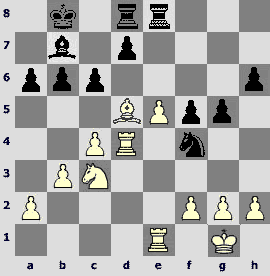
I think that this response was a great surprise for Etienne. Black weakens some squares but keeping the bishop b7 from the exchange he takes the e5-pawn e5 quickly and cynically.
22.Ґf3 ўc7. Precision and confidence are seen in every move of Morozevich. 22.¤g6!? 23.e6 g4! 24.Ґd1 ўc7µ.
23.ўf1 ¦e6 24.g3 ¤g6 25.Ґh5 ¤xe5 26.f4 gxf4 27.gxf4 c5! An important intermediate move. After 27...¤g4 28.¦xe6 dxe6 29.¦xd8 ўxd8 30.Ґxg4 fxg4 White has a strong response 31.c5!
28.¦d2. Theintermediate check didn't change anything crucially 28.¤d5+ ўb8 29.¦d2 ¤g4 30.Ґf7 (30.Ґxg4 fxg4 31.f5 ¦f8µ) 30...¦xe1+ 31.ўxe1 ¦f8µ.
28...¤f3.This isone of two ways to win. Probably, it is even more accurate. 28...¤g4!? 29.¦xe6 dxe6 30.¦xd8 ўxd8 31.Ґxg4 fxg4 32.ўf2 Ґf3µ.
29.Ґxf3 Ґxf3 30.¦xe6 dxe6 31.¦xd8 ўxd8°
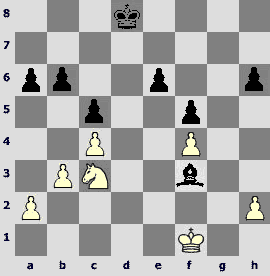
We can drop the curtain. Black has a won endgame with an extra pawn. Further in the game Alexander didn't hurry and acted cautiously. Consistency and reliability of Black's play in this game impressed the author very much.
32.¤a4 ўc7 33.ўf2 Ґc6 34.¤c3 ўd6 35.ўe3 e5 36.¤e2 Ґd7 37.a3 Ґe6 38.¤g3 a5! 39.a4 Ґd7 40.¤e2 Ґc6 41.¤c3 ўe6‡ 42.¤e2 Ґe4 43.¤c1 exf4+ 0–1
Playing with fire
Such playing doesn't always lead to good. However, there are some universal laws. But sometimes an opponent is just ready to play according to your rules. And at least he is not inferior to you.
A.Morozevich(2748) – G.Kasparov (2851) A00
Frankfurt 2000
1.¤c3
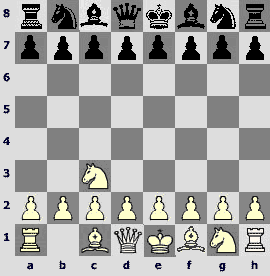
By no means was this event on the last place in the list of Mikhail Savinov. The opening of the game is a bit unusual indeed.
1...c5 2.d4. The "eventness" of the first move of White didn't concern to this game. But this is the way the Muscovite began his game in the World championship in San Luis, which reduced to the banal Sicilian defense, though: 2.¤f3 ¤f6 3.e4 d6 4.d4 cxd4 5.¤xd4 a6 6.Ґe3 Morozevich – Polgar, San Luis 2005.
2...cxd4 3.Јxd4 ¤c6 4.Јh4 ¤f6 5.¤f3 d5 6.Ґg5 Јa5 7.0–0–0 Ґe6. As a matter of fact, it is still an opening but the opponents have already abandoned the trodden paths. That's why now it is possible for me to say my word of commentator.
8.Ґd2?! This move is a bit passive. It was only the previous move when White dashingly developed his bishop to an active position... 8.¤d4!? seems to be more interesting... 8...¤e4?! 9.¤xe4 ¤xd4 10.¤d6+! exd6 11.¦xd4І. And it was also possible to play a preventive 8.a3!?
8...g6 9.e4?!

It seems that the position of Black becomes more pleasant after this move though it is impossible to speak about the advantage yet. 9.¤a4 Јc7 10.¤c5 Ґf5„.
9...d4 10.e5. Compulsory adherence to principle. 10.¤b1 Јxa2 11.Ґg5 Ґg7 12.¤xd4 0–0–0°.
10...¤g4! Exactly! 10...dxc3 11.Ґxc3 Јxa2 looks very tempting but after 12.exf6› the position can not be assessed clearly.
11.¤xd4™ ¤xd4 12.h3 Ґg7. Again the development is the most important thing. 12...Ґf5 13.hxg4 Ґxc2 14.¦e1› or 12...¤xe5 13.Јxd4 Ґg7 14.Ґb5+ ўf8 15.Јe4› look worse.
13.hxg4 Ґxe5 14.a3 ¦c8
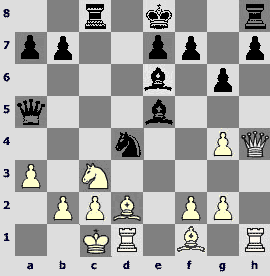
Black can't castle, that's why he "has to force" the pressure on the queenside. 14...Јc7!? would be also quite good.
15.Ґd3. To keep the unclear position on the board White had to make another preventive move – 15.ўb1!?
15...¤b3+. Kasparov relieves the tension by this move. 15...b5!? led to a more complicated game.
16.cxb3 Ґxc3 17.Ґxc3 ¦xc3+
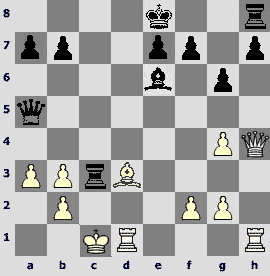
18.ўb1?
Playing for a win against the world champion is worthy of respect in every possible way but objectively the position didn't dispose to it. It is also should be remembered that it was a rapid game. 18.bxc3 Јxc3+ 19.Ґc2 (19.ўb1 Јxb3+ 20.ўc1 Јc3+ 21.ўb1=) 19...Ґxb3 20.¦d2 Јa1+ 21.Ґb1 Јc3+ 22.Ґc2 (22.¦c2 Ґxc2 23.Ґxc2 Јxa3+і) 22...Јa1+= led to the draw.
18...¦xb3 19.Јh2 Јc3! It seems that Alexander underestimated this attack. It is really weaker to play a poor-spirited 19...ўf8?! 20.Ґc2 ¦b5 21.Јh6+ ўg8›, and it is a real pleasure to look at the h8-rook.
20.Јb8+ Ґc8 21.¦d2 0–0 22.Јh2? After this move the position of White becomes quite bad and Morozevich fails to confuse the opponent even with subsequent resourceful play. He could keep a greater vagueness by playing22.Јf4 ¦xb2+ 23.¦xb2 Јxd3+ 24.¦c2 h5!і.
22...h5 23.¦hd1 Ґxg4 24.f3 Ґe6 25.g4 hxg4! 26.fxg4 Ґxg4 27.¦g1 Ґxb2+!°

A final chord. I think that the rest of the game was played on time.
28.¦xb2 Јxd3+ 29.Јc2 Јd7 30.Јd2 Јxd2 31.¦xd2 Ґf3° 32.ўb2 Ґc6 33.ўc3 ўg7 34.ўb4 e5 35.a4 a6 36.a5 e4 37.ўc5 ¦e8 38.¦e1 ¦e6 39.ўd4 f5 40.¦h2 ўf6 41.¦h8 ¦d6+ 42.ўc5 ¦d5+ 43.ўb6 ¦b5+ 44.ўc7 ¦xa5 0–1
Nevertheless, it is necessary to finish the first part of the article on a cheerful note. It will be wrong to consider that Alexander is strong only on his territory, in his crooked schemes and non-standard positions. Instead of proving it in a long and tiresome way I will just give an example of the brilliant and absolutely positional game performed by Morozevich.
A.Morozevich (2590) – P.Svidler (2690) B80
Maikop 1998
I promise not to overload the analysis of this game with the comments. I'll note the main issues in advance. After the Black's mistake in the opening (10...Ґb4?) White got an advantage and increased it very skillfully. It's advantageous for White to exchange heavy pieces in order to make black pawns even more vulnerable despite the fact that opposite-colored bishops are on board.
1.e4 c5 2.¤f3 d6 3.d4 cxd4 4.¤xd4 ¤f6 5.¤c3 ¤c6 6.f3 e6 7.Ґe3 Ґe7 8.Јd2 0–0 9.0–0–0 d5 10.Јe1 Ґb4?
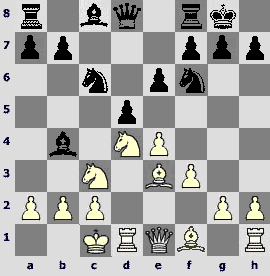
11.a3 Ґa5 12.¤b3 Ґxc3 13.Јxc3 Јc7 14.Ґc5 ¦d8 15.Ґb5! Ґd7 16.Ґxc6 Ґxc6 17.e5 ¤d7 18.Ґd6 Јb6 19.¤d4І

19...¦ac8 20.Јb4 a5?! 21.Јxb6 ¤xb6 22.b3 ¤d7 23.Јd3! b6 24.¦c3 Ґb7 25.¦xc8 ¦xc8 26.ўb2 Ґc6 [26...f6? 27.exf6 e5 28.¤f5ќ] 27.¦d1
27...h6 28.¦d3 ¤c5 29.¦c3
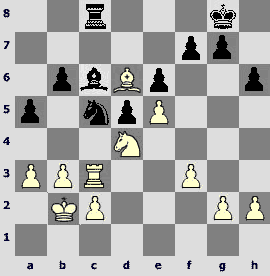
29...Ґd7 30.a4 f6 31.¤b5 ¤a6? [31...ўh7!?±] 32.¦xc8+ Ґxc8 33.exf6 gxf6 34.Ґe7ќ ўg7 35.Ґd8 ¤b8 36.Ґxb6 ¤c6 37.c3 e5 38.¤c7!

38...d4 39.cxd4 exd4 40.¤b5 d3 41.ўc3 Ґe6 42.Ґe3 ¤b4 43.¤d4 Ґf7 44.Ґd2 ўg6 45.ўb2 1–0. In my opinion White didn't make a single wrong move in this game.
